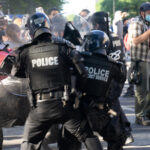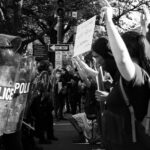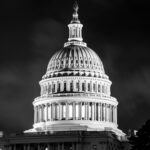Violence is defined as “the intentional use of physical force or power, threatened or actual, against oneself, another person, or against a group or community, that either result in or has a high likelihood of resulting in injury, death, psychological harm, maldevelopment or deprivation (Cooper et al., 2004, p. 1109).” Violence has been recognized as a public health issue because it is a behavior that results from biological, environmental, systemic, and social stressors that harm health. Police violence can manifest in several forms, including physical violence from excessive use of force, psychological violence, sexual violence, and neglectful violence (Cooper et al., 2004).
Physical Violence
Physical violence resulting from police use-of-force practices can cause physical injuries and premature death. The International Association of Chiefs of Police describes use-of-force as “the amount of effort required by police to compel compliance by an unwilling subject” (National Institute of Justice, 2020). However, there is no regulation or nationally recognized standard for what constitutes a reasonable use of force, leaving many community members open to abuse by police. The lack of stringent use-of-force policies has facilitated excessive physical violence perpetrated by police and subsequent public health consequences, including injury and death.
Examples of physical abuse by police include civilians being hit, kicked, dragged, or beaten (Cooper et al. 2004). One of the first video-recorded incidents of physical abuse by police to go “viral” was that of Rodney King, who in 1992 was brutally beaten by several police officers resulting in severe injuries including skull fractures, broken teeth, and permanent brain damage. Though the horrific crime was captured on video, the four police officers indicted for the attack were acquitted by a jury. After nearly 30 years, incidences of police brutality and violence captured on video continue to go viral, some ending fatally for the victims, as in the case of George Floyd and many others. Although advancements in technology have made police violence more visible to the general public, many instances of physical abuse by police officers are not caught on camera and remain largely unpunished.
Psychological Violence
Psychological violence can result from verbal abuse, unnecessary threats or intimidation, and gratuitous prolonged discomfort during police stops (H. Cooper et al., 2004). Psychological violence also occurs with excessive police surveillance in racial/ethnic minority neighborhoods and racial profiling in pedestrian and vehicle stops (Bowleg et al., 2020; Legewie, 2016). Even in the absence of physical violence, inappropriate stops (i.e., stops without probable cause) are associated with adverse mental health outcomes when perceived as discriminatory or unfair (APHA, 2018).
Sexual Violence
Sexual violence perpetrated by police officers can range from sexual humiliation to sexual victimization, such as inappropriate sexual contact, public strip searches, and sexual assault (Cooper & Fullilove, 2016; Ross, 2017).
Neglectful Violence
Neglectful violence is a form of abuse that results when law enforcement does not respond to civilians’ calls for help or responds too late or inappropriately (DeVylder et al., 2017).
- American Public Health Association. (2018). Addressing Law Enforcement Violence as a Public Health Issue [Policy Report]. https://www.apha.org/policies-and-advocacy/public-health-policy-statements/policy-database/2019/01/29/law-enforcement-violence
- Bowleg, L., Maria del Río-González, A., Mbaba, M., Boone, C. A., & Holt, S. L. (2020). Negative Police Encounters and Police Avoidance as Pathways to Depressive Symptoms Among US Black Men, 2015–2016. American Journal of Public Health, 110 (Suppl 1), S160–S166. https://doi.org/10.2105/AJPH.2019.305460
- Cooper, H. L. F., & Fullilove, M. (2016). Editorial: Excessive Police Violence as a Public Health Issue. Journal of Urban Health : Bulletin of the New York Academy of Medicine, 93(Suppl 1), 1–7. https://doi.org/10.1007/s11524-016-0040-2
- Cooper, H., Moore, L., Gruskin, S., & Krieger, N. (2004). Characterizing Perceived Police Violence: Implications for Public Health. American Journal of Public Health, 94(7), 1109–1118. DOI: 10.2105/ajph.94.7.1109 https://www.ncbi.nlm.nih.gov/pmc/articles/PMC1448406/
- DeVylder, J. E., Frey, J. J., Cogburn, C. D., Wilcox, H. C., Sharpe, T. L., Oh, H. Y., Nam, B., & Link, B. G. (2017). Elevated Prevalence of Suicide Attempts among Victims of Police Violence in the USA. Journal of Urban Health : Bulletin of the New York Academy of Medicine, 94(5), 629–636. https://doi.org/10.1007/s11524-017-0160-3
- Legewie, J. (2016). Racial Profiling and Use of Force in Police Stops: How Local Events Trigger Periods of Increased Discrimination. American Journal of Sociology, 122(2), 379–424. https://doi.org/10.1086/687518
- National Institute of Justice, 2020. Overview of police use of force. https://nij.ojp.gov/topics/articles/overview-police-use-force accessed August 18, 2023.
- Ross, C. T. (2017). Digging deeper: Population-level racial disparities, exposure to police victimisation and psychological trauma. Epidemiology and Psychiatric Sciences, 26(5), 478–480. https://doi.org/10.1017/S2045796017000130



